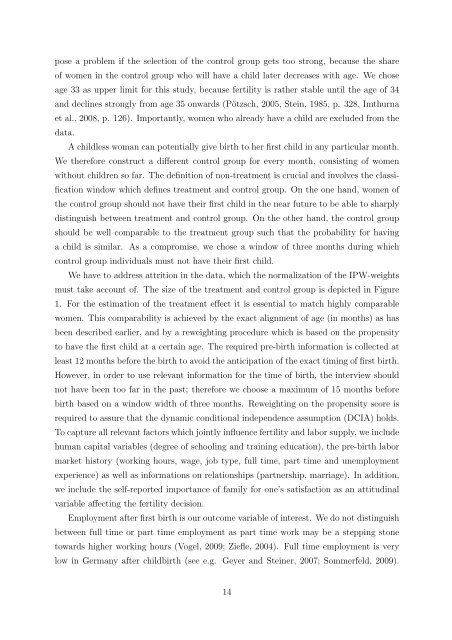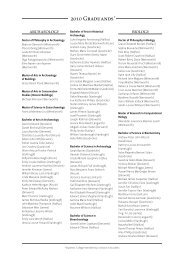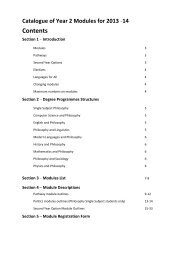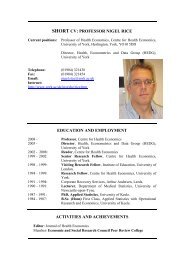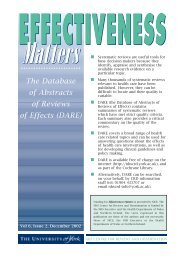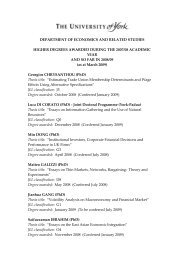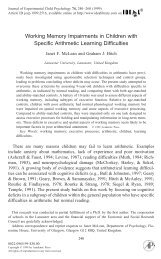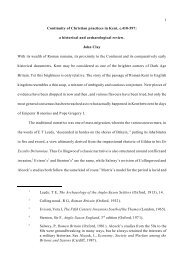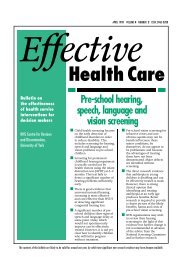Causal effects on employment after first birth - A ... - University of York
Causal effects on employment after first birth - A ... - University of York
Causal effects on employment after first birth - A ... - University of York
Create successful ePaper yourself
Turn your PDF publications into a flip-book with our unique Google optimized e-Paper software.
pose a problem if the selecti<strong>on</strong> <strong>of</strong> the c<strong>on</strong>trol group gets too str<strong>on</strong>g, because the share<strong>of</strong> women in the c<strong>on</strong>trol group who will have a child later decreases with age. We choseage 33 as upper limit for this study, because fertility is rather stable until the age <strong>of</strong> 34and declines str<strong>on</strong>gly from age 35 <strong>on</strong>wards (Pötzsch, 2005, Stein, 1985, p. 328, Imthurnaet al., 2008, p. 126). Importantly, women who already have a child are excluded from thedata.A childless woman can potentially give <strong>birth</strong> to her <strong>first</strong> child in any particular m<strong>on</strong>th.We therefore c<strong>on</strong>struct a different c<strong>on</strong>trol group for every m<strong>on</strong>th, c<strong>on</strong>sisting <strong>of</strong> womenwithout children so far. The definiti<strong>on</strong> <strong>of</strong> n<strong>on</strong>-treatment is crucial and involves the classificati<strong>on</strong>window which defines treatment and c<strong>on</strong>trol group. On the <strong>on</strong>e hand, women <strong>of</strong>the c<strong>on</strong>trol group should not have their <strong>first</strong> child in the near future to be able to sharplydistinguish between treatment and c<strong>on</strong>trol group. On the other hand, the c<strong>on</strong>trol groupshould be well comparable to the treatment group such that the probability for havinga child is similar. As a compromise, we chose a window <strong>of</strong> three m<strong>on</strong>ths during whichc<strong>on</strong>trol group individuals must not have their <strong>first</strong> child.We have to address attriti<strong>on</strong> in the data, which the normalizati<strong>on</strong> <strong>of</strong> the IPW-weightsmust take account <strong>of</strong>. The size <strong>of</strong> the treatment and c<strong>on</strong>trol group is depicted in Figure1. For the estimati<strong>on</strong> <strong>of</strong> the treatment effect it is essential to match highly comparablewomen. This comparability is achieved by the exact alignment <strong>of</strong> age (in m<strong>on</strong>ths) as hasbeen described earlier, and by a reweighting procedure which is based <strong>on</strong> the propensityto have the <strong>first</strong> child at a certain age. The required pre-<strong>birth</strong> informati<strong>on</strong> is collected atleast 12 m<strong>on</strong>ths before the <strong>birth</strong> to avoid the anticipati<strong>on</strong> <strong>of</strong> the exact timing <strong>of</strong> <strong>first</strong> <strong>birth</strong>.However, in order to use relevant informati<strong>on</strong> for the time <strong>of</strong> <strong>birth</strong>, the interview shouldnot have been too far in the past; therefore we choose a maximum <strong>of</strong> 15 m<strong>on</strong>ths before<strong>birth</strong> based <strong>on</strong> a window width <strong>of</strong> three m<strong>on</strong>ths. Reweighting <strong>on</strong> the propensity score isrequired to assure that the dynamic c<strong>on</strong>diti<strong>on</strong>al independence assumpti<strong>on</strong> (DCIA) holds.To capture all relevant factors which jointly influence fertility and labor supply, we includehuman capital variables (degree <strong>of</strong> schooling and training educati<strong>on</strong>), the pre-<strong>birth</strong> labormarket history (working hours, wage, job type, full time, part time and un<strong>employment</strong>experience) as well as informati<strong>on</strong>s <strong>on</strong> relati<strong>on</strong>ships (partnership, marriage). In additi<strong>on</strong>,we include the self-reported importance <strong>of</strong> family for <strong>on</strong>e’s satisfacti<strong>on</strong> as an attitudinalvariable affecting the fertility decisi<strong>on</strong>.Employment <strong>after</strong> <strong>first</strong> <strong>birth</strong> is our outcome variable <strong>of</strong> interest. We do not distinguishbetween full time or part time <strong>employment</strong> as part time work may be a stepping st<strong>on</strong>etowards higher working hours (Vogel, 2009; Ziefle, 2004). Full time <strong>employment</strong> is verylow in Germany <strong>after</strong> child<strong>birth</strong> (see e.g. Geyer and Steiner, 2007; Sommerfeld, 2009).14


